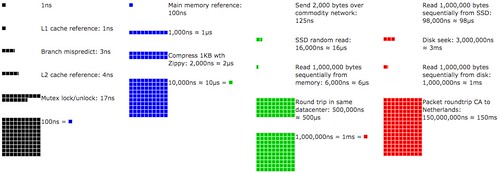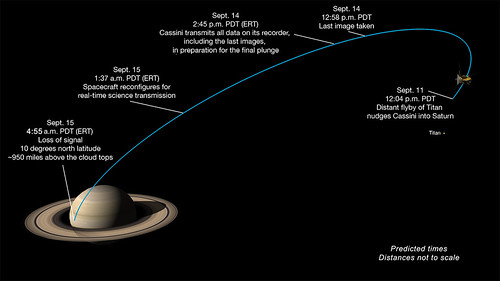Stuff The Internet Says On Scalability For October 6th, 2017
 Friday, October 6, 2017 at 9:17AM
Friday, October 6, 2017 at 9:17AM Hey, it's HighScalability time:

LiDAR sees an enchanted world. (Luminar)
If you like this sort of Stuff then please support me on Patreon.
- 14TB: Western Digital Hard Drive; 3B: Yahoo's perfidy; ~80%: companies traded on U.S. stock market 1950-2009 were gone by 2009; 21%: conversion increase with AI-enabled site personalisation; $1 billion: US Air Force jets off the cloud; 1 billion: iOS devices in use; 1000x: new DeepMind WaveNet model produces 20 seconds of higher quality audio in 1 second; 96: vCPUs on new GCE machine type, with 624GB of memory;
- Quotable Quotes:
- fusiongyro: The amount of incipient complexity in programming has been growing, not going down. What's more complex, "hello, world" to the console in Python, or "hello world" in a browser with the best and newest web stack? Mobility and microservices create lots of new edge cases and complexity—do non-programmers seem particularly well-equipped to handle edge cases to you? The problem has never really been the syntax—if it were, non-programmers would have made great strides with Applescript and SQL, and we'd all be building PowerBuilder libraries for a living. The problem is that programming requires a mode of thinking which is difficult. Lots of people, even people who do it daily, who are trained to do it and exercise great care and use great tool tools, are not great at it. This is not a syntax problem or a lack of decent libraries problem. We have simple programming languages with huge bodies of libraries. What's hard is the actual programming.
- @troyhunt: 1 person didn’t patch Struts, got Equifax breached, sold shares & created dodgy search site with bad results. Right?
- @rob_pike: Once in a while I need to build some large system written in C or C++ and am reminded why we made Go. #golang
- @adam_chal: Me before #strangeloop: I'm not a real programmer unless I know Haskell Me after #strangeloop: I'm not a real programmer unless I knit
- Julian Squires: I make a petty point about premature optimization; don't go out and rewrite your switch statements as binary searches by hand; maybe do rewrite your jump tables as switch statements, though.
- @GossiTheDog: Re this - vuln scanners only find the vuln if you point them at a Struts URL. If you just point them at hostname or IP, it won’t find vuln.
- @stevesi: Yes very much. Not unlike Wells Fargo trying to find a mid-level manager who signed people up for credit cards independent of metrics/execs.
- @patio11: We would laugh out of the room a CEO who said "The reason that we didn't file our taxes last year was an employee forgot to buy a stamp."
- @swardley: In general, the reasons for hybrid cloud have nothing to do with economics & everything to do with executives justifying past purchases
- @asymco: Changes in Android propagate to users over six years. iOS propagates in about three months.
- bb611: It isn't luck [re: Incident: France A388 over Greenland on Sep 30th 2017, fan and engine inlet separated]. It is the result of millions of engineering hours spent on the development of highly reliable and resilient passenger aircraft, an emphasis on public identification and dissemination of design weaknesses, errors, and failures, and an unwavering focus by industry regulators on safety.
- @mipsytipsy: "I would rather have a system that's 75% 'down' but users are fine, than a system 99.99% 'up' but user experience is impacted." #strangeloop
- psyc: A huge proportion of the ICOs I investigate turn out to be pure facade. It's amazing to me just how quickly this con was honed and formalized, but I guess people have always been good at aping when it comes to get-rich-quick bandwagons. The standard ICO consists solely of: 1) A slick website. 2) A well-produced video. 3) A whitepaper that discusses trivially standard blockchain features and goals. No differentiation necessary. 4) The appearance that prominent or well-credentialed people are working on the "technology". That's all. The "product" is vapor. The real product is another pump & dump vehicle to satisfy the insatiable demand for pump & dump vehicles. This product is sold to the "investors" during the ICO. Said "investors" are even explicitly awarded more coins for shilling the pump everywhere by creating amateurish articles and YouTube videos.
- nameless912~ As a developer at a company that's trying to shove Lambda down our throats for EVERYTHING...AWS needs to get better at a few key things before Lambda/serverless become viable enough that I'll actually consider integrating them into my services: 1. Permissions are a nightmare. 2. Networking is equally nightmarish. 3. If the future of compute is serverless, then Lambda, Google Cloud Functions, and whatever half-baked monstrosity Azure has cooked up are going to have to get together and define a common runtime for these environments.
- @erikstmartin: “OS’s are dinosaurs. Let them rest” - @nicksrockwell #velocityconf
- @bridgetkromhout: Thought experiment: what if all your systems restart at once? How long does it take you to recover? *Can* you? @whereistanya #velocityconf
- Eric Hammond: Some services, like API Gateway, are far more complicated, difficult to use, and expensive than I expected before trying. Other services, like Amazon Kinesis Streams, are simpler, cheaper, and far more useful than I expected.
- nameless912: please, please chop off my hands and pull out my eyeballs if cloud computing becomes yet another workflow engine. I though we killed those off in the 90s.
- MIT: The proof-of-principle experiment that Neill and Roushan and co have pulled off is to make a chip with nine neighboring loops and show that the superconducting qubits they support can represent 512 numbers simultaneously.
- @swardley: Equifax: We're a security nightmare! Adobe: Hold my beer Deloitte: Hold my beer Yahoo: Amateurs. Learn from a pro -
- @somic: seeing more & more indicators these days that devops as a unifying idea is now dead. devops appears now to be ops who can write simple code
- @slightlylate: So true. I'll trade 10 devs who are high on abstractions and metaprogramming for one who gives a damn about the user.
- @postwait: I am just a single data point, but I use about 10% of my CS education (CS/MSe/~PhD) daily; about 50% of it monthly. I value it immensely.
- @mweagle: The Go compiler will likely slow down your first sprint. It will radically improve your marathon performance.
- There are many more quotes. Click through to the full article to read them. Or not. Up to you.
- The Coming Software Apocalypse. After all these years it's still strange to see people fall into the "if we only had complete requirements we could finally make reliable systems, what's wrong with these idiots?" tarpit. Requirements are a trap. We went through all of this with waterfall and big design up front. It doesn't work. Requirements are no less complex and undiscoverable than code. Tools are another trap. Tools are code. Tools encode one perspective on a solution space and if there's anything the real world is good at, it's destroying perspective. IMHO, our mostly likely future is to treat programming as an act of computational creativity. Human programmers will work with AIs to co-create software systems. We'll work together to produce better software than a human can on their own or an AI can produce on it's own. We're better together, which is why I'm not afraid AI will replace programmers. Here's an example in music, A.I. Experiments: A.I. Duet, where a computer accompanies a piano player. Here's a better example—Ripples - A piano duet for improvising musician and generative software—where the AI piano player riffs off a human in real-time. You can imagine this is how sofware will be built in the future. Here's a hint at the productivity gain, thought it isn't a complete example, because what I'm talking about doesn't exist yet: @DynamicWebPaige: Blue lines: @Google's old Translate program, 500k lines of stats-focused code. Green: now, 500 lines of @tensorflow. See also, Jeff Dean On Large-Scale Deep Learning At Google and Peter Norvig on Machine Learning Driven Programming: A New Programming For A New World.
Don't miss all that the Internet has to say on Scalability, click below and become eventually consistent with all scalability knowledge (which means this post has many more items to read so please keep on reading)...





















